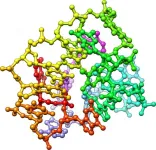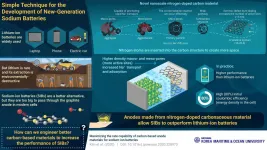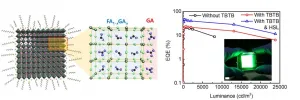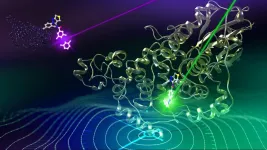Identification of Oligo-DNA that promotes skeletal muscle differentiation
2021-01-25
(Press-News.org) Skeletal muscle is the largest tissue in the human body and is responsible not only for locomotion but for energy metabolism and heat production. Age-related muscle atrophy reduces motor function and contributes to the need for nursing care. In addition, muscle atrophy associated with various chronic diseases is known to be a risk factor for life expectancy. Myoblasts, the progenitor cells of muscle, play an important role in maintaining muscle homeostasis. However, it has been reported that the differentiation ability of myoblasts decreases with age and disease, and this is thought to be one of the causes of muscle atrophy. In order to prevent or treat muscle atrophy, a research team led by Assistant Professor Tomohide Takaya of Shinshu University, Faculty of Agriculture studied molecules that promote myoblast differentiation.
The research group focused on oligo-DNA (short single-stranded DNA), which exhibits diverse activities in vivo. As a result of searching for sequences that promote myoblast differentiation among 50 types of oligo-DNA derived from the genome sequence of lactobacilli, they found that an 18-base oligo-DNA with telomere sequence has an extremely strong inducing effect on myoblast differentiation. This "myogenetic oligo-DNA" (myoDN) acts as an aptamer that binds to protein nucleolin in myoblasts by forming a characteristic three-dimensional structure. As a result, myoDN was found to promote myoblast differentiation by inhibiting nucleolin function and ultimately activating the p53 signaling pathway.
The number of people with muscle atrophy is increasing in our hyper-aged society. The deterioration of people's motor function, QOL, and life expectancy due to muscle atrophy is now a major social problem. One possible solution to this problem is the activation of muscle stem cells, and the research team searched for molecules that promote the differentiation of muscle stem cells or muscle formation.
Usually, in such research screenings, scientists look for molecules that act on a predetermined target. However, the group of researchers wanted to find a new molecule that had never been found before, so a target was not set, and instead the group searched for a molecule that would act on a predetermined target. Prof. Takaya constructed an experimental system to reliably determine only whether the final indicator, muscle formation was achieved or not. As a result, the group was fortunate enough to find a unique molecule, myoDN. Oligo-DNA derived from the genome sequence of lactic acid bacteria was identified to differentiate myoblasts. This myoDN is expected to be applied as a nucleic acid medicine as a useful molecule for the prevention and treatment of muscle diseases including muscle atrophy.
myoDN was designed by the co-author of the study, Dr. Takeshi Shimosato, also of the Faculty of Agriculture, Shinshu University. myoDN was originally designed as an immunomodulatory molecule, but unfortunately, it did not have that function and was stored as a rejected molecule in the Shimosato lab. Nobody understood how myoDN worked when it was first found. However, the relationship between the three-dimensional structure and molecular function of myoDN was completely consistent with predictions of computer simulations performed by Dr. Koji Umezawa of the Faculty of Agriculture, Shinshu University and the actual experimental results.
The fate of stem cells can be controlled by oligo-DNA derived from microbial genomes but not contain genetic information. The ultimate goal is to develop myoDN-based drugs for the treatment of muscle atrophy and muscle diseases in humans so that people will be able to continue to live a vigorous life even as they age. As the world's first oligo-DNA that promotes muscle differentiation, myoDN is expected to be developed for application as a preventive and therapeutic agent for muscle atrophy.
INFORMATION:
This study was supported in part by Grants-in Aid from the Japan Society for the Promotion of Science (16K19397 and 19K05948), the TOBE MAKI Scholarship Foundation (17-JA-503), the Skylark Food Science Institute, the Takano Science Foundation, the Japan Society for Bioscience, Biotechnology, and Agrochemistry, and a Grant-in-Aid from the Fund of Nagano Prefecture to Promote Scientific Activity (H30-3-3).
The Supplementary Material for this article can be found online at: https://www.frontiersin.org/articles/10.3389/fcell.2020.616706/full#supplementary-material
[Attachments] See images for this press release:

ELSE PRESS RELEASES FROM THIS DATE:
2021-01-25
Laser beams can be used to precisely measure an object's position or velocity. Normally, however, a clear, unobstructed view of this object is required - and this prerequisite is not always satisfied. In biomedicine, for example, structures are examined, which are embedded in an irregular, complicated environment. There, the laser beam is deflected, scattered and refracted, often making it impossible to obtain useful data from the measurement.
However, Utrecht University (Netherlands) and TU Wien (Vienna, Austria) have now been able to show that meaningful results can be obtained even in such complicated environments. Indeed, there is a way to specifically modify ...
2021-01-25
Depression, especially in urban areas, is on the rise, now more than ever. Mental health outcomes are influenced by, among other things, the type of environment where one lives. Former studies show that urban greenspace has a positive benefit on people experiencing mental ill health, but most of these studies used self-reported measures, which makes it difficult to compare the results and generalise conclusions on the effects of urban greenspace on mental health.
An interdisciplinary research team of UFZ, iDiv and Leipzig University tried to improve this issue by involving an objective indicator: prescriptions of antidepressants. To find out whether a specific type of 'everyday' green space - street trees dotting the neighbourhood sidewalks ...
2021-01-25
A lot is known about galaxies. We know, for instance, that the stars within them are shaped from a blend of old star dust and molecules suspended in gas. What remains a mystery, however, is the process that leads to these simple elements being pulled together to form a new star.
But now an international team of scientists, including astrophysicists from the University of Bath in the UK and the National Astronomical Observatory (OAN) in Madrid, Spain have taken a significant step towards understanding how a galaxy's gaseous content becomes organised into a new generation of stars.
Their findings have important implications for our understanding of how stars formed during the early days of the universe, when galaxy collisions were frequent and dramatic, and star and galaxy formation ...
2021-01-25
Children of mothers experiencing depressive symptoms are more at risk, as adolescents, of experiencing suicidal thoughts and attempting suicide.
New research suggests that this link may be explained by loneliness, potentially opening new ways for youth suicide prevention.
The study - by the universities of Exeter, Montréal, Laval and McGill - used data from more than 1,600 families from the Québec Longitudinal Study of Child Development, a representative sample of new-borns in Quebec followed from birth to 20 years of age.
Mothers were asked about depressive symptoms (such as sadness and losing interest ...
2021-01-25
As the world becomes aware of the imminent environmental crisis, scientists have begun a search for sustainable energy sources. Rechargeable batteries like lithium-ion batteries are seeing a popularity surge, concurrent with production of "greener" technologies such as electric propulsion ships (which are being developed to meet the environmental regulations by the International Maritime Organization) and other electric vehicles. But, lithium is rare and difficult to distribute, putting its sustainability in doubt while also risking sharp increases in cost. Researchers have thus turned ...
2021-01-25
To predict when earthquakes are likely to occur, seismologists often use statistics to monitor how clusters of seismic activity evolve over time. However, this approach often fails to anticipate the time and magnitude of large-scale earthquakes, leading to dangerous oversights in current early-warning systems. For decades, studies outside the seismology field have proposed that these major, potentially devastating seismic events are connected to a range of non-seismic phenomena - which can be observed days or even weeks before these large earthquakes occur. So far, however, this idea hasn't caught on in the wider scientific community. In this special issue, EPJ Special Topics proposes the Global Earthquake Forecasting System (GEFS): the first collaborative initiative ...
2021-01-25
Scientists have shown where bird species would exist in the absence of human activity under research that could provide a new approach to setting conservation priorities.
A study by Durham University, UK, in collaboration with the Royal Society for the Protection of Birds (RSPB), investigated how human activities such as agriculture, deforestation, and the drainage of wetlands have shaped where bird species are found in Great Britain today.
Researchers used data on the geographical distributions of bird species alongside simulation models to predict where bird species would exist today if the effects of human activities on the landscape were removed.
In this scenario there were winners ...
2021-01-25
Public health researchers, led by UNSW Sydney, have estimated the number of cancer cases requiring surgery globally each year, predicting the number will rise from 9.1 million to 13.8 million from 2018 to 2040 - an increase of 52 per cent or 4.7 million cases.
Their research shows the greatest relative increase will occur in 34 low-income countries, where the number of cases requiring surgery is expected to more than double by 2040 (314,355 cases to 650,164, or 107 per cent).
The modelling study, published in The Lancet Oncology on Friday, analysed global demand for cancer surgery and estimated surgical and anaesthesia ...
2021-01-25
Research team at Seoul National University (Prof. Tae-Woo Lee) and University of Pennsylvania (Prof. Andrew M. Rappe) developed perovskite light-emitting diodes (PeLEDs) with an external quantum efficiency (EQE) of 23.4%. The research results were published in Nature Photonics, which is the world-renowned international academic journal, on January 4th (Title: Comprehensive defect suppression in perovskite nanocrystals for high-efficiency light-emitting diodes).
Metal halide perovskites have very narrow spectral emission, excellent color purity, low material cost, and wide and easy color-tunability. ...
2021-01-25
The Nagoya University Institute of Transformative Bio-Molecules (WPI-ITbM) research team of Designated Associate Professor Tsuyoshi Hirota, Postdoctoral Fellow Simon Miller, Professor Kenichiro Itami and graduate student Tsuyoshi Oshima (Research Fellowship for Young Scientists, JSPS), in collaboration with the group of Professor Ben Feringa and Postdoctoral Fellow Dušan Kolarski of Groningen University in the Netherlands, have achieved a world first: fully reversible manipulation of the period of the circadian clock using light, by exchanging part of a compound with a light-activated switch.
Waking in the ...
LAST 30 PRESS RELEASES:
[Press-News.org] Identification of Oligo-DNA that promotes skeletal muscle differentiation







